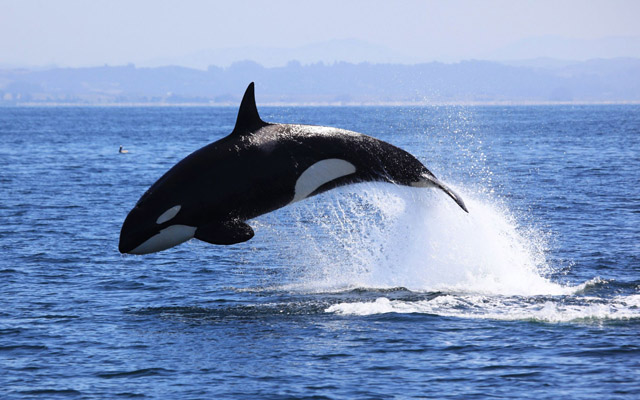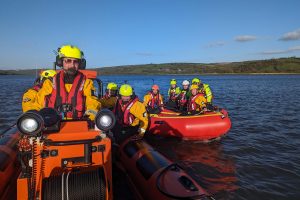
LAST SATURDAY, an unusual marine mammal was spotted off Strumble Head in Pembrokeshire, according to the Sea Watch Foundation. According to their website, one of their observers, Caroline Webb, reported her sighting to the organisation, which holds the UK database for sightings of whales, dolphins and porpoises.
Initially thought to be a squid-eating Risso’s dolphin, there was something about the description of the animal that didn’t ring true; it was seen devouring a seal pup!
Caroline Webb said: “There was a struggle going on and a pool of blood was spreading on the surface of the water. It had the rounded blunt head of a Risso’s dolphin but the whole thing appeared to be dark and not pale. We saw the head clearly when it came out of the water to go for the seagulls. It was near a bay where a baby seal was known to have been lying, about half a mile east of Strumble Head.”
According to the SWF, killer whales are known to visit the Irish Sea occasionally and have been seen off the coast of Wales on a number of occasions although sighting reports attributed to the species are often unconfirmed. Those that were confirmed include four killer whales seen off Bardsey Island in June 2013, a solitary animal recorded from the ferry between Dublin and Holyhead in May 2012, and six killer whales seen travelling north off South Stack, Anglesey in August 2011. There was also an unverified report of a killer whale off nearby Mwnt, in Ceredigion, back in July. However, most Welsh sightings have been west of Pembrokeshire in the waters referred to as the Celtic Deep.
Dr Peter Evans, Sea Watch’s Director, told The Herald: “Essentially, the size of the whale, the shape of its head and description of its fin, along with the observation of an actual seal attack make it difficult to attribute the sighting to anything else other than killer whale.”
Dr Evans added: “One might have expected the white oval patch behind the eye to have been seen but at a distance in dull light, this can easily go unnoticed. Since the fin was described as recurved rather than erect and triangular, it was probably either an immature male or adult female.”
“We don’t know very much about the movements of killer whales (or orcas as we prefer to call them) on the west coast of Britain. Members of a pod that has numbered up to fourteen can be seen annually around the Hebrides of west Scotland, mainly in summer. The most famous of these is a mature male nicknamed “John Coe” that we have observed since at least 1980. It has a distinct nick towards the base of the dorsal fin making it instantly recognisable (and recently gained a chunk out of its tail, possibly a shark bite). Sightings of John Coe have ranged from the Hebrides over to East Scotland, south to the northwest coast of Ireland and well into the Irish Sea off West Wales – a true wanderer,”
Kathy explained that the sighting could not be verified. She explained: “So although we couldn’t give Caroline a 100% definite ID for the animal she witnessed, everything she told us leads us to believe it was a killer whale feeding off Strumble Head.”
Kathy added: “This is really exciting news for wildlife enthusiasts and I would urge them to take to the headlands of West Wales these coming days to see if they can catch up with the animal. If people do see this or any other whale, dolphin or porpoise, they should report them to Sea Watch. All the information we can gather about these majestic animals allows us to protect and conserve them gong forwards”














Add Comment